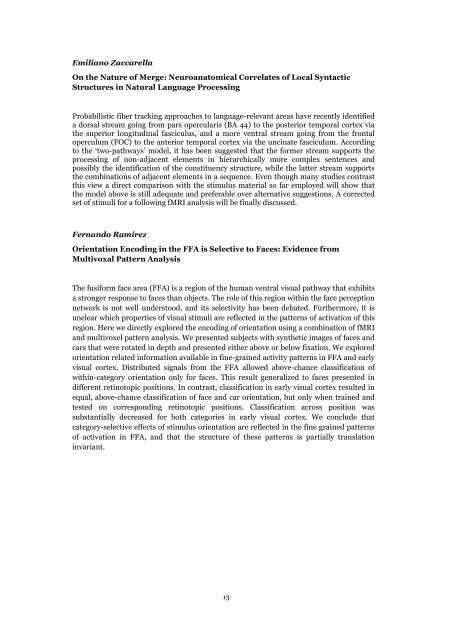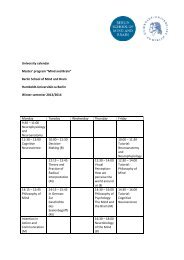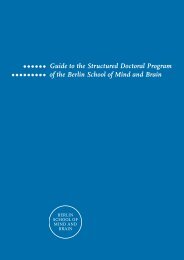Download - Berlin School of Mind and Brain
Download - Berlin School of Mind and Brain
Download - Berlin School of Mind and Brain
You also want an ePaper? Increase the reach of your titles
YUMPU automatically turns print PDFs into web optimized ePapers that Google loves.
Emiliano Zaccarella<br />
On the Nature <strong>of</strong> Merge: Neuroanatomical Correlates <strong>of</strong> Local Syntactic<br />
Structures in Natural Language Processing<br />
Probabilistic fiber tracking approaches to language-relevant areas have recently identified<br />
a dorsal stream going from pars opercularis (BA 44) to the posterior temporal cortex via<br />
the superior longitudinal fasciculus, <strong>and</strong> a more ventral stream going from the frontal<br />
operculum (FOC) to the anterior temporal cortex via the uncinate fasciculum. According<br />
to the ‘two-pathways’ model, it has been suggested that the former stream supports the<br />
processing <strong>of</strong> non-adjacent elements in hierarchically more complex sentences <strong>and</strong><br />
possibly the identification <strong>of</strong> the constituency structure, while the latter stream supports<br />
the combinations <strong>of</strong> adjacent elements in a sequence. Even though many studies contrast<br />
this view a direct comparison with the stimulus material so far employed will show that<br />
the model above is still adequate <strong>and</strong> preferable over alternative suggestions. A corrected<br />
set <strong>of</strong> stimuli for a following fMRI analysis will be finally discussed.<br />
Fern<strong>and</strong>o Ramirez<br />
Orientation Encoding in the FFA is Selective to Faces: Evidence from<br />
Multivoxal Pattern Analysis<br />
The fusiform face area (FFA) is a region <strong>of</strong> the human ventral visual pathway that exhibits<br />
a stronger response to faces than objects. The role <strong>of</strong> this region within the face perception<br />
network is not well understood, <strong>and</strong> its selectivity has been debated. Furthermore, it is<br />
unclear which properties <strong>of</strong> visual stimuli are reflected in the patterns <strong>of</strong> activation <strong>of</strong> this<br />
region. Here we directly explored the encoding <strong>of</strong> orientation using a combination <strong>of</strong> fMRI<br />
<strong>and</strong> multivoxel pattern analysis. We presented subjects with synthetic images <strong>of</strong> faces <strong>and</strong><br />
cars that were rotated in depth <strong>and</strong> presented either above or below fixation. We explored<br />
orientation related information available in fine-grained activity patterns in FFA <strong>and</strong> early<br />
visual cortex. Distributed signals from the FFA allowed above-chance classification <strong>of</strong><br />
within-category orientation only for faces. This result generalized to faces presented in<br />
different retinotopic positions. In contrast, classification in early visual cortex resulted in<br />
equal, above-chance classification <strong>of</strong> face <strong>and</strong> car orientation, but only when trained <strong>and</strong><br />
tested on corresponding retinotopic positions. Classification across position was<br />
substantially decreased for both categories in early visual cortex. We conclude that<br />
category-selective effects <strong>of</strong> stimulus orientation are reflected in the fine grained patterns<br />
<strong>of</strong> activation in FFA, <strong>and</strong> that the structure <strong>of</strong> these patterns is partially translation<br />
invariant.<br />
13





